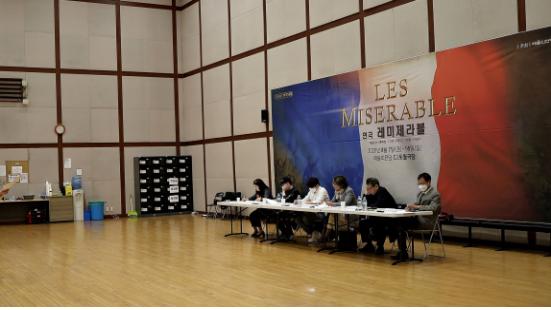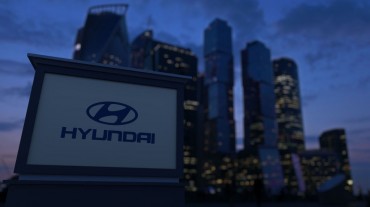
This photo provided by Les Miserables Korea on June 11, 2020, shows the casting panel at an audition for the upcoming Korean-language theater production of “Les Miserables” slated for Aug. 7-16 in Seoul.
SEOUL, June 11 (Korea Bizwire) — An unusually high number of people have auditioned for supporting roles in an upcoming production of “Les Miserables” in South Korea, the production company said Thursday, highlighting the severe competition for jobs among stage actors in a market hit hard by the new coronavirus crisis.
Theater company Les Miserable Korea said that the number of applicants for vacant supporting roles in the Korean-language theater adaptation of the French classic musical reached around 1,400. The show is slated for Aug. 7-16 at the Seoul Arts Center.
Stage veterans, including Oh Hyun-kyung, Park Woong, Im Dong-jin and Jeong Sang-cheol, are currently on board the production. The audition was held to cast more younger actors in the show.
The company said it hired some 50 new actors from the audition.
“The fact that some 1,400 auditioned for the roles reflects the current state of our performing arts industry,” said Chung Dal-young, professor of theater management at Seoul’s Dongguk University, who was a member of the casting panel.
Chung added, “Even considering that a lot of shows have been canceled due to COVID-19 and that the project is a timeless classic, the turnout was larger than expected.”
The performing arts industry has been among the worst-hit sectors by COVID-19 in South Korea, with aggregate ticket sales of musicals, plays, classical concerts and other performances in April plummeting to 4.68 billion won (US$3.84 million) from the 20.9-billion-won tally in February.
(Yonhap)







People say that the COVID death rate is 0.40% ! This was circulated in several news channels also !
Me Thinks the death rate is beyond 10%,on aggregate count,and for some nations it is way beyond.
As per – https://www.worldometers.info/coronavirus/#countries = there are 7.5 million cases and 420000 dead.Simple numerics place it at proximating 6%.
Wrong me says ! dindooohindoo
India,Brazil,Russia have seen a sharp rise in cases,in the last 30 days.40% of their cases came in the last 30 days,and for India,it will worsen exponentially.If you see the kill data of the RIB in the BRICS – it has increased sharply,in the last 30 days (which proves my thesis)
People dying today,were in the quasi morgue (hospitals) 30-60 days ago.Let us take it,at 30 days.
So we rewind to 30 days ago,and exclude the jump in RIB of BRICS,in the last 30 days. So we have say 4.5 million cases and the kill quant is 420,000
Rate proximates 10% ! But that is also wrong,as the infected are NOT solely on RTPCR mode.Many nations cannot afford it and are doing antibody tests.An antibody positive may be RTPCR negative,and the vice versa is less likely. If you exclude these specimens from the infected tally,the % rises further.
Also have to exclude the recovered cases – as those with immunity will recover in 30 days – AS THE VIRUS was DESIGNED THAT WAY.Unlike HIV and Cancer – where patients are NOT likely to recover- on a generic mode.But those who recover from COVID -WILL (in part) come back again,and then die.That will double count the infected cases.Hence,we exclude the recovered cases (which are 4 million,as per site stated above).
These Johnnies who recouped,may have been infected,say 15 days ago – and if you rewind to 15 days ago,and deduct the spike in the RIBs of the BRICS – you will have an infected base of,say 6 million.If you remove the recovered (4 million),and then ratio it,to the dead of 420000 – then you have a
kill ratio of 21% !
Cannot compare the dead to the entire population – as of this instant – as it would include billions of aged,morbid and asymptomatics – who will get infected very soon.
If we take a 1 year horizon – then post the 1 year – you could take the global population – as that by that time,the virus would have had enough time,to spread,evolve and mutate (across the latitudes and seasons).At that stage,a ratio w.r.t the population,would be a meaningful statistic – to benchmark intra and inter se,with other diseases.By that time the death rate will mature and the complete breakdown of the health imfrastructure will be apparent (to explain the future geometric rise)